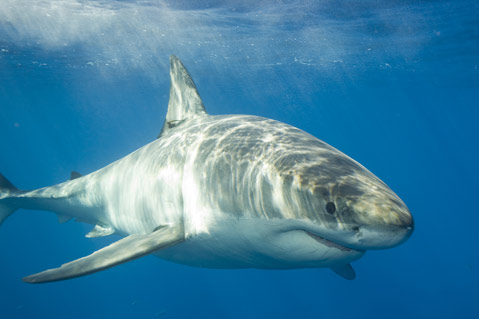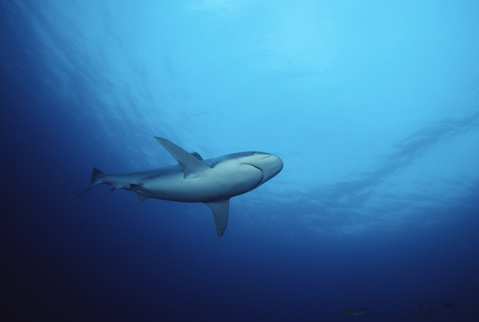Sharks and Humans Getting to Know Each Other in the S.B. Channel
A Biting History

If you’ve spent any real time hanging out on, under, or around the ocean waters of Santa Barbara, chances are you have heard at least one good shark story. While some are confirmed (like the six-foot juvenile great white caught less than two weeks ago near Rincon, brought in alive to the Santa Barbara Harbor, tagged, and then released about a mile offshore) and others are suspect (like the story of a seal being taken by a shark right off a buoy outside of Sterns Wharf or a famous professional big wave surfer being chased back to his jet ski by a 15-foot great white west of Hollister Ranch this past spring), there are others, with a blood stained, torn flesh legacy, that are undeniable.
Don’t tell the tourism board, but every now and again somebody enjoying the fruits of the Santa Barbara Channel winds up on the receiving end of a shark chomp. While it hasn’t happened in a few years, fearless ocean-goers can rest assured it will happen again. As seminal shark authority Dr. Chris Lowe, the lead biologist at California State University at Long Beach’s world famous Shark Lab, summed it up last month, “Every summer there are going to be shark attacks somewhere in the world no matter what. : Eventually, it will be at a beach near you.”

According to a survey of historic newspaper clippings, and corroborated by Ralph Collier’s ambitious book, Shark Attacks of the Twentieth Century: From the Pacific Coast of North America, there have been eight people attacked by sharks in Santa Barbara County during the past four decades. Considering the number of people using the water each day-be it for work or play-this number, which equals roughly one shark attack every 1,734 days, is something in which we can certainly find solace. Further, all of the victims have been divers of some sort, usually on the prowl for sea urchins or, in the days of yore, abalone, at far-flung aquatic outposts like Point Conception or San Miguel Island.
This peace of mind of course goes flying out the window, right along with rational thought, for the average ocean enthusiast when tragedy strikes, much like it did this past April in San Diego when 66-year-old Dave Martin was killed by a great white while going for an early morning swim. Or, in 2003, when Deborah Franzman was similarly taken in the near-shore waters of Avila Beach. Mathematics aside, the bottom line remains, as Santa Barbara shark attack victim Rob Rebstock put it, “The ocean is a shark’s native habitat. They can show up anywhere at any time.”
Here in the 805, the only fatal shark attack occurred on December 9, 1994, near Castle Rock on San Miguel. A beloved local urchin diver, Jim “Weener” Robinson, was surveying the urchin scene some 65 feet down at the start of another day’s work out at the Channel Islands when he ran into trouble. Bit below the waste, Robinson was preceded to the surface by a large pool of blood and, though he made it back aboard alive, he would succumb to his injuries only a few minutes later. Believed to have been hit by a great white, Weener’s injuries were so severe that, according to Tom Kendrick’s Blue Water Gold Rush, an attending emergency physician at Goleta Valley Hospital would later opine, “Even if it had happened on the steps of the hospital, I don’t think we could have saved him.”
Oddly enough, easily the most famous shark attack in S.B. history-and perhaps the world-was not Robinson’s passing but an attack on a skin diving UCSB student near Point Conception during the famous Jaws summer of 1975. With the whole world afraid of the beach thanks to Steven Spielberg’s Academy Award-winning film, the aforementioned Rob Rebstock, who still calls Santa Barbara home, went for a day of causal abalone diving with his brother and a buddy on July 23, 1975. After launching their 16-foot wooden boat out of Gaviota, the crew made their way west, past Hollister Ranch, headed toward Government Point.
In a funny twist of fate, they encountered commercial ab hunter Gary Johnson who, having had his swim fin chomped by a great white in the area just a few days prior, warned the boys about a lurking and toothy 17-foot beast. Being recreational divers, the boys figured Johnson’s story was a little more than a scare tactic meant to keep them away from an area usually fished only by professionals. “Yeah, he warned us,” recalled Rebstock, “but we were skeptical of it. He showed us a fin that he said was bit, but it looked perfect.”
The omens didn’t stop there. Just after running into Johnson, the trio came across a buoy floating with a “huge stainless steel hook and a big hunk of fish on it.” Presumably set to try and catch a very big fish, Rebstock said that the unusual fishing tactic gave more credit to Johnson’s warning. “After seeing that, I was like, ‘Okay, I’m not going diving today.'”
But in the end, a sun-soaked afternoon with dozens of abalone visible on the bottom from the boat proved to be too much of a temptation for Rebstock, and they wound up dropping anchor near some rocks just past the lighthouse at Point Conception. The first one in, Rebstock was treading water and waiting for his gear to be passed to him when he was bit. “I hadn’t been in the water for more than two minutes when all of a sudden the ocean just erupted underneath me,” remembered Rebstock. “With me in its mouth, the shark thrust me totally out of the water. I remember looking down on the boat.”
Luckily for Rebstock, the great white released him in mid-air, basically dropping him back in the water right next to the safety of the boat. With literally one arm stroke, he was back on board and quickly headed for shore. Once on the beach and after cutting away his wetsuit, he was able to survey the damage. “It looked like meat hanging in a butcher shop when I looked down into it,” said Rebstock. His right thigh was cut open to the bone while his left leg had eight picture-perfect puncture wounds in an arc from his ankle to his knee. Using an old sweatshirt as a tourniquet, Rebstock waited more than an hour on the beach near Cojo reef for an ambulance to make the drive out from Lompoc (the help call was sent out with a short wave radio from a nearby oil facility). “I was lucky,” said Rebstock, “it was a gentle mouthing, really, for such a big thing like that.”
All stitched up, Rebstock was sent home to his apartment in Isla Vista that night-some of his wounds purposely left open to drain. While the life-threatening action was over, the drama had only just begun. Already in a frenzy about the box office smash Jaws, which opened mere days before Rebstock’s attack, the media gobbled up the real-life story of his great white encounter. “It was crazy. There were TV crews on my lawn when I woke up the next morning. Literally, I was front page news around the world,” said Rebstock with a laugh.


